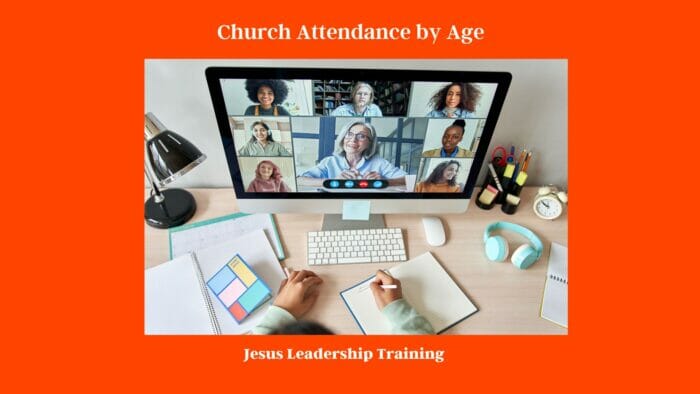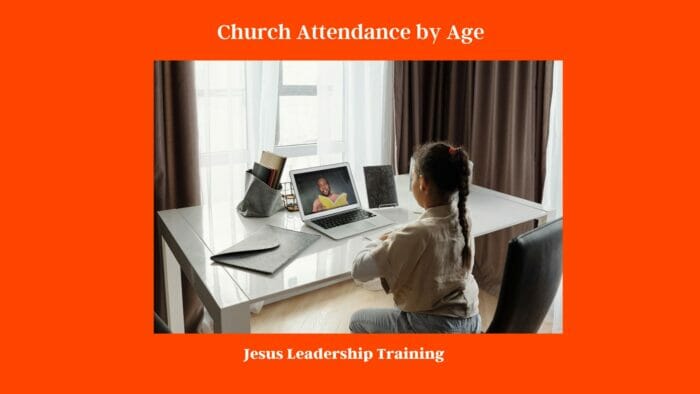Church Attendance by Age – Explore the comprehensive article on church attendance by age, delving into trends, factors influencing attendance, and its impact on different age groups. Gain insights into the challenges faced by churches and discover potential solutions to foster higher attendance rates.
Table of Contents
Introduction: The Role of Church Attendance in Different Age Groups (Religious)
Church attendance is a significant aspect of religious practice, offering individuals a sense of community, spiritual growth, and emotional support. However, the patterns of attendance can vary greatly across different age groups. In this article, we will explore the trends in church attendance among various age demographics and investigate the factors that influence participation. We will also discuss the impact of church attendance on different age groups, focusing on its role in shaping beliefs, values, and overall well-being.

Church Attendance by Age: A Comprehensive Analysis (United States)
Understanding the dynamics of church attendance is crucial for religious institutions and communities. Here, we present a detailed examination of church attendance patterns among different age groups, from children to seniors, to provide a holistic perspective on this topic.
Note that these are not exact figures and may vary:
| Age GroupGeneral Church Attendance Trend | |
|---|---|
| Children (0-12) | Often high, dependent on parental involvement. |
| Teens (13-19) | Generally moderate, may decrease with age. |
| College Age (20-24) | Often lower, due to life changes & newfound independence. |
| Young Marrieds (25-35) | Can be variable, might increase if raising a family or seeking community. |
| Middle Age (36-60) | Generally moderate to high, often seeking community and spiritual guidance. |
| Seniors (60+) | Often high, driven by established habits and seeking fellowship. |
Again, this table illustrates broad trends and the actual attendance can vary greatly depending on a multitude of factors including cultural, societal, personal, and more. For precise data, I would recommend referring to specific research or surveys done in the demographic and geographic area of your interest.
What is Vision Casting – Proverbs 29:18 says, “Where there is no vision, the people perish
Check this vision – I would follow this – Greg Gaines

Most Influencial Factors to Increase Church Attendance
| Most Influential Factors to Increase Church Attendance |
|---|
| 1. Engaging Worship Services |
| Engaging and uplifting worship services are one of the most significant factors that attract and retain attendees. Inspiring music, heartfelt worship, and relevant messages that resonate with the congregation’s spiritual needs create an environment where people feel connected to God and one another. |
| 2. Strong Biblical Preaching and Teaching |
| The faithful and compelling proclamation of God’s Word is paramount in drawing individuals to church and fostering their spiritual growth. A pastor’s ability to deliver clear, relevant, and practical messages that apply biblical principles to real-life situations can profoundly impact attendance and nurture a hunger for spiritual learning. |
| 3. Vibrant Community and Fellowship |
| A welcoming and vibrant church community that fosters genuine relationships plays a crucial role in increasing attendance. When people feel accepted, loved, and supported by fellow believers, they are more likely to become active and committed members of the church family. |
| 4. Effective Evangelism and Outreach |
| Proactive and intentional efforts in evangelism and community outreach can significantly impact church attendance. Engaging in compassionate initiatives, organizing evangelistic events, and actively inviting others to experience God’s love can attract new attendees and expand the church’s reach. |
| 5. Youth and Children’s Ministries |
| Investing in dynamic and engaging youth and children’s ministries is vital for long-term church attendance growth. Providing age-appropriate programs and activities that cater to the spiritual needs of young generations fosters their sense of belonging and encourages families to stay committed to the church. |
| 6. Effective Leadership and Vision |
| Strong and visionary leadership plays a pivotal role in church growth. A clear sense of purpose, direction, and strategic planning under the guidance of capable leaders inspires confidence and motivates members to actively participate in the church’s mission. |
| 7. Prayer and Spiritual Emphasis |
| Prayer is the foundation of church growth. A church that prioritizes corporate and individual prayer, seeking God’s wisdom and guidance, experiences His transformative power, which positively influences attendance and overall spiritual vitality. |
| 8. Accessible and Inclusive Facilities |
| Providing accessible and welcoming facilities can make a significant difference in church attendance. Facilities that cater to the needs of the congregation, including families with young children and individuals with disabilities, create a more inviting and accommodating atmosphere. |
| 9. Effective Communication and Media Presence |
| Utilizing effective communication strategies, both within the church and through various media platforms, helps to keep the congregation informed and engaged. A strong media presence and clear communication about church events and activities can attract new attendees and retain current members. |
| 10. Cultivating a Culture of Servanthood |
| A church that encourages a culture of servanthood and active involvement in ministries fosters a sense of ownership and commitment among its members. When individuals are actively using their gifts and talents to serve others, they become more invested in the church’s growth and mission. |
Note: The order of influence may vary depending on the specific context and dynamics of each church community.

Healthy church will Minister to all Age Levels (Americans)
A healthy church recognizes the importance of ministering to all age levels as a fundamental aspect of its mission and impact. The Scriptures teach that the body of Christ is composed of diverse members, each contributing unique gifts and perspectives (1 Corinthians 12:12-27).
From the youngest to the oldest, every individual is valued and essential in fulfilling the church’s purpose. Ministering to all age levels ensures that the church remains relevant and inclusive, meeting the spiritual needs of every member within the congregation.
Furthermore, a multi-generational approach to ministry fosters a sense of unity, mutual respect, and intergenerational mentorship. The elderly provide wisdom and experience, the middle-aged offer stability and leadership, while the youth infuse the church with energy and fresh perspectives.
A holistic approach to ministry, encompassing all age groups, creates a dynamic and thriving church community, where everyone can grow, serve, and experience the fullness of God’s grace.
Church Attendance by Age: Children and Teens (Religious Preference)
Church attendance plays a pivotal role in shaping the spiritual foundation of children and teenagers.
Churches that implement engaging youth programs often witness higher attendance rates among children and teens. These programs may include interactive learning sessions, community service opportunities, and fun social events. Nurturing a sense of belonging within this age group fosters a lasting connection to the church community.

Important Items that Teens are Drawn to in Church (Religious Tradition)
here is a table highlighting the important elements that typically draw teenagers to a church:
| Elements | Explanation |
|---|---|
| Engaging Youth Programs | Teens often appreciate programs designed specifically for them, which meet their unique needs and interests. |
| Authentic Relationships | Genuine friendships with peers and mentor-like relationships with older members can make a significant impact. |
| Relevance | Messages that apply to their daily lives, tackling issues they’re facing such as school, relationships, and personal growth. |
| Involvement | Opportunities to serve and be actively involved in the church can give teens a sense of ownership and belonging. |
| Supportive Environment | A safe space where they can openly express their thoughts, doubts, and questions without judgment. |
| Fun and Fellowship | Enjoyable activities and social events that foster fellowship can make the church more appealing. |
| Spiritual Growth Opportunities | Teens are often in search of meaning and purpose, and will be attracted to environments that help them grow spiritually. |
| Inspiring Worship Experiences | Worship services that engage their emotions and resonate with them can be powerful. |
Keep in mind that these are general observations. The specifics may vary for each individual, as teens have diverse preferences and experiences. It’s always best to engage directly with the teens in your church to understand what they value and need.
Church Attendance by Age: Young Adults and College Students (Service Attendance)
As young adults embark on their journey to independence, their church attendance patterns may fluctuate. LSI Keywords: college life, faith exploration.
During their college years, many young adults experience a phase of faith exploration. Churches that offer support groups and college ministries can help maintain attendance among this demographic. Such programs provide a safe space for open discussions and the exchange of ideas.
Important Items that College and young adults are Drawn to in a church (Church Membership)
Certainly, here is a table highlighting the key elements that typically attract college students and young adults to a church:
| Elements | Explanation |
|---|---|
| Relevance | Sermons and teachings that address their life situations and societal issues. |
| Community | A sense of belonging and genuine connections with others in the same life stage. |
| Mentorship and Guidance | Access to mature and wise individuals who can guide them in their spiritual journey. |
| Service Opportunities | Chances to give back and contribute to the church and broader community. |
| Open Discussions | Spaces where they can ask tough questions, express doubts, and explore faith. |
| Cultural Engagement | Recognition and thoughtful responses to current societal and cultural issues. |
| Personal Development | Resources and opportunities to grow in skills, leadership, and spirituality. |
| Authentic Worship | Worship experiences that resonate with them emotionally and spiritually. |
It’s important to note that these elements could vary significantly depending on the individual’s unique needs and circumstances. Direct engagement and conversation with the individuals within these demographics can yield the most accurate understanding of what they value and seek in a church community.
Church Attendance by Age: Adults in Their Prime
For adults in their prime, church attendance may be influenced by various factors, including work commitments and family responsibilities. LSI Keywords: work-life balance, spiritual growth.
Churches can cater to this age group by organizing flexible worship schedules and offering family-friendly activities. Additionally, providing opportunities for personal and spiritual growth through workshops and seminars can positively impact attendance.
Church Attendance by Age: Middle-Aged Adults
Middle-aged adults often seek deeper connections within their faith community. LSI Keywords: community involvement, religious guidance.
Churches that emphasize community involvement and offer mentorship programs can attract and retain middle-aged attendees. These initiatives help individuals find support and guidance during significant life transitions.
Important Items that Midde age adults are Drawn to in a church (Pre Pandemic)
Of course, here’s a table outlining the key elements that often attract middle-aged adults to a church:
| Elements | Explanation |
|---|---|
| Family Programming | Activities and programs that accommodate families, including children and teens. |
| Stability | A stable and consistent church community that provides a sense of security. |
| Sermons with Depth | Theological teachings that deepen their understanding of faith. |
| Opportunities for Service | Ways they can use their skills and experience to contribute to the church and community. |
| Fellowship | Spaces to build meaningful relationships with peers. |
| Leadership Opportunities | Positions or roles where they can influence the church’s direction and impact. |
| Life Guidance | Teachings and resources to help navigate mid-life challenges and transitions. |
| Community Impact | Visible efforts and initiatives that make a difference in the local community. |
Remember that individual preferences and needs can differ, so engaging directly with the middle-aged demographic in your church can provide a more accurate understanding of what they value in their church experience.
Church Attendance by Age: Seniors and Retirees
For seniors and retirees, church attendance often remains a stable and meaningful aspect of their lives. LSI Keywords: spiritual fulfillment, social interaction.
Churches can further enrich the experience of senior attendees by providing transportation services, ensuring accessibility, and organizing social gatherings. These efforts promote a sense of belonging and spiritual fulfillment within the church community.
Important Items that Seniors are Drawn to in a church
Certainly, here’s a table outlining the essential elements that typically attract seniors to a church:
| Elements | Explanation |
|---|---|
| Fellowship Opportunities | Spaces and events that allow seniors to build relationships and combat loneliness. |
| Accessible Services | Services that consider mobility issues, such as easy building access or hearing-assistance devices. |
| Meaningful Sermons | Messages that resonate with their life experiences and spiritual growth. |
| Prayer Groups | Groups focused on prayer, providing comfort and spiritual connection. |
| Care Ministries | Support for seniors in times of illness or need, such as visitation programs or meal delivery. |
| Legacy Opportunities | Ways for seniors to leave a lasting impact on the church, such as mentoring younger generations or contributing to a specific project. |
| Life Stage Groups | Small groups or classes specifically designed for seniors. |
| Traditional Worship Styles | Services that honor and incorporate traditional hymns, liturgy, and practices that seniors might be accustomed to. |
Remember that the preferences of seniors can vary greatly, so open dialogue with this demographic within your church can provide further insight into their specific needs and desires.
Factors Influencing Church Attendance by Age
The decision to attend church varies significantly among age groups and is influenced by a multitude of factors. Understanding these determinants can help religious institutions design strategies to increase attendance and engagement.
Influence of Family and Social Circles
For children and young adults, family plays a vital role in shaping their religious identity and church attendance habits. When children witness their parents’ commitment to attending church, they are more likely to adopt the same practices. Similarly, peer pressure among teenagers can positively impact church attendance if they have friends who actively participate in religious activities.
Generational Values and Beliefs
Generational values and beliefs heavily influence church attendance patterns. While older generations may emphasize tradition and religiosity, younger generations may prioritize spirituality and personal growth. Understanding these differences can help tailor church programs to cater to the preferences of each age group.
Basic Generational Values That are Present in a Healthy Church
Absolutely, here’s a table illustrating some fundamental generational values that contribute to the health of a church:
| Generational Values | Explanation |
|---|---|
| Inter-generational Engagement | This involves different age groups interacting, learning from one another, and fostering mutual respect. |
| Respect for Traditions | Honoring and incorporating traditional practices in church services helps respect and retain the wisdom of older generations. |
| Adaptability | Adapting to changing times, such as using digital technology, can cater to the younger generation’s needs and ways of communication. |
| Diversity | Inclusivity of various ethnic, social, and age groups enriches the church experience and mirrors the diversity of the global Church. |
| Community Outreach | Efforts towards community service can be a common value shared by all generations, fostering unity in action. |
| Spiritual Growth Opportunities | Programs that promote spiritual development, such as Bible study groups, cater to every generation’s need for spiritual growth. |
| Strong Leadership | The presence of strong, ethical leadership is important to all generations and contributes to the overall health of a church. |
| Emphasis on Relationships | A focus on developing strong, meaningful relationships is valued by all generations and contributes to a sense of community. |
Remember, each church is unique, and these values might manifest in various ways depending on the congregation’s specific characteristics and context.
Societal and Technological Changes
As society evolves, technological advancements have an undeniable impact on church attendance. Churches that embrace digital platforms and live streaming services can reach a broader audience, including those who may not attend physical gatherings. Creating interactive online communities fosters a sense of connection for those unable to participate in traditional ways.
Life Events and Transitions
Life events, such as marriage, birth, loss of a loved one, or retirement, can significantly influence church attendance. During times of joy or hardship, individuals may turn to their faith community for support and guidance, leading to increased attendance.
Church Leadership and Community Involvement
Effective church leadership and community involvement play a crucial role in attracting and retaining attendees across all age groups. Churches that prioritize pastoral care and outreach programs create an environment where individuals feel valued and connected.
The Impact of Church Attendance on Different Age Groups
Church attendance can have profound effects on the lives of individuals belonging to different age groups. Understanding these impacts is essential for religious institutions seeking to foster spiritual growth and well-being.
Impact on Children and Teens
For children and teens, consistent church attendance can foster moral development and character building. Engaging with religious teachings and participating in community service activities instill values of compassion, empathy, and kindness.
Impact on Young Adults and College Students
Church attendance can provide young adults and college students with a sense of identity and belonging. Amid the challenges of transitioning to adulthood, church communities offer social support and opportunities for personal growth.
Important Items that Singles are Drawn to in a church
| Importance Ranking | Items Attracting Singles to a Church |
|---|---|
| 1 | Meaningful Worship Services: Engaging sermons, moving worship music |
| 2 | Belonging: A warm and welcoming community, feeling of inclusivity |
| 3 | Relevant Teaching: Messages applicable to their life stage |
| 4 | Active Singles Ministry: Activities and events targeted to singles |
| 5 | Opportunities for Service: Ways to use their talents and gifts |
| 6 | Spiritual Growth Opportunities: Bible studies, prayer groups |
| 7 | Social Events: Opportunities to meet and connect with others |
| 8 | Pastoral Care and Guidance: Access to counseling and spiritual mentoring |
| 9 | Clear Communication: Up-to-date and accessible information about the church |
| 10 | Outreach Programs: Involvement in the local community and missions |
Please note that these items can vary depending on the individual’s personal preferences and religious beliefs.
Impact on Adults in Their Prime
Church attendance can serve as a source of stress relief and spiritual rejuvenation for adults in their prime. Regularly engaging in worship and fellowship can create a sense of balance amidst the demands of work and family life.
Impact on Middle-Aged Adults
LSI Keywords: life transitions, emotional well-being.
Church attendance offers middle-aged adults a supportive space during significant life transitions. Being part of a faith community can provide emotional stability and guidance during uncertain times.
Impact on Seniors and Retirees
For seniors and retirees, church attendance contributes to social connectedness and a sense of purposeful living. Engaging in religious activities and interacting with fellow members can enhance overall well-being.
Frequently Asked Questions (FAQs)
Q: Is church attendance declining among younger generations?
A: While there has been a decline in church attendance among some younger generations, others are seeking alternative forms of spiritual expression. Churches are adapting by embracing digital platforms and creating engaging programs to cater to the preferences of young attendees.
Q: How can churches encourage children to attend regularly?
A: Churches can promote regular attendance among children by organizing interactive and age-appropriate programs that focus on character building, creativity, and community service.
Q: Are there any benefits of attending church during retirement?
A: Yes, attending church during retirement can offer seniors a sense of belonging, social interaction, and emotional support, contributing to their overall well-being.
Q: What role does technology play in increasing church attendance?
A: Technology plays a significant role in increasing church attendance by allowing churches to reach a broader audience through live streaming services, online communities, and interactive digital platforms.
Q: How can churches support young adults during their college years?
A: Churches can support young adults during their college years by offering college ministries, mentorship programs, and safe spaces for open discussions about faith and life.
Q: How do life events impact church attendance?
A: Life events can lead to increased church attendance as individuals seek support and guidance during times of joy or hardship.
Final Thoughts: Fostering Meaningful Church Attendance Across All Ages
Church attendance by age is a multifaceted topic, with diverse factors influencing participation among different age groups. As religious institutions continue to adapt to societal changes and embrace technology, they can foster meaningful church attendance experiences that cater to the spiritual needs of individuals at every stage of life.
By recognizing the impact of church attendance on personal growth, community building, and overall well-being, churches can continue to serve as beacons of hope and support for people of all ages. Let us strive to create inclusive and nurturing environments where attendees, regardless of age, find solace, purpose, and a deeper connection to their faith.
Best Bible Encyclopedias and Dictionaries
Below is a table featuring some highly regarded Bible Encyclopedias and Dictionaries along with their publishers and websites where they can be found or purchased.
| Title | Publisher | Website |
|---|---|---|
| The International Standard Bible Encyclopedia | Eerdmans | Eerdmans |
| Zondervan’s Pictorial Bible Dictionary | Zondervan | Zondervan |
| Easton’s Bible Dictionary | Thomas Nelson | Thomas Nelson |
| Holman Illustrated Bible Dictionary | B&H Publishing Group | B&H Publishing Group |
| The New Unger’s Bible Dictionary | Moody Publishers | Moody Publishers |
| HarperCollins Bible Dictionary | HarperOne | HarperOne |
| Vine’s Complete Expository Dictionary of Old and New Testament Words | Thomas Nelson | Thomas Nelson |
You can generally find these resources on the publishers’ websites, as well as other online book retailers such as Amazon or Christianbook. It’s always good practice to confirm availability and review additional details on the specific websites or other reliable online bookstores.




